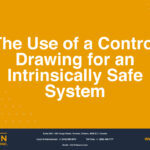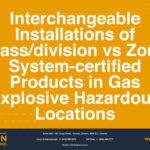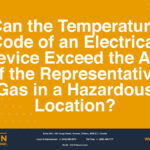
Preventing Gas Explosions
We are all aware of the destruction that can be caused by gas explosions, so we need to understand what causes them and how to prevent them. Areas where flammable gases are present meet the definition of “hazardous locations”.
Examples of hazardous areas are chemical factories, gasoline storage and dispensing areas, dry cleaning plants, refineries, paint workshops, tank facilities and loading areas for flammable gases, liquids, and solids.
For an explosion to take place, all three components of the “fire triangle” must be present at the same time. First, a flammable substance, the “fuel”, must be present in sufficient quantities. It may be in the form of a gas, a liquid, or a solid. Second, oxygen (air) must be present and in the correct proportions. An explosion cannot take place in an oxygen-free environment. And finally, there must be an “ignition source” – something that provides the energy for combustion. Electrical equipment can provide an ignition source because an electrical circuit can raise the temperature of equipment surfaces and also generate even brief, seemingly harmless arcs and sparks. In other words, two main sources of ignition from an electrical equipment are hot surfaces and arcs and sparks.
Even though electrical devices can present or create conditions that become explosive if all the required elements of the fire triangle are present, electrical equipment is still required, even in hazardous locations.
Electrical equipment installed in hazardous locations must therefore be protected so explosions are prevented!
Four methods are commonly used, sometimes in combination:
- Contain the internal explosion, should an explosion exist
- Isolate the ignition source from the explosive atmosphere
- Limit the energy of the ignition source
- Avoid the presence of the ignition source
The first method involves containing the explosion, should there be one. In this method, a strong, sealed explosion-proof or flame-proof enclosure prevents an explosion from spreading to the exterior of the electrical device and the atmosphere surrounding its enclosure. The temperature of the external surface of the explosion-proof enclosure must not be high enough to ignite a surrounding flammable atmosphere. This approach is referred as containment and its protection technique is Explosion proof.
The second approach involves isolating the source of ignition from the explosive atmosphere. The source of ignition (heated surfaces or sparks) is isolated from an explosive atmosphere, encapsulating the device in a resin, or immersing it in oil. Or the device can be filled with sand or glass or quartz particles that keep an ignitable mixture from forming inside. Or the enclosure of the electrical equipment can be purged and replaced by clean air or an inert protective gas. The internal atmosphere is then pressurized so that the pressure inside the enclosure is higher than the pressure of the surrounding atmosphere. This keeps an explosive atmosphere from entering. This approach is referred to as Hazard Isolation, and the projection techniques area encapsulation, oil immersion, powder filling and purging and pressurization.
A third method involves energy limitation. The energy of a spark caused by electrical equipment is not enough to ignite a surrounding gas. Furthermore, the rise in temperature of the device’s surfaces is limited. This technique limits the energy during normal or even abnormal circuit conditions. This approach is referred as energy limitation, and its protection technique is intrinsic safety.
And finally, some electrical devices and their components are, by design, “non-arcing“. They do not contain any arcing or sparking parts and all the hot surfaces are identified and controlled to be less than the ignitable temperature of the surrounding gas. There are no sources of ignition inside the device’s enclosure so they are therefore this technique is called avoidance of presence of ignition source. This approach is referred as avoidance of ignition source and its protection techniques are called increased safety, non-arcing and non-sparking.
In summary, ignition of a flammable/combustible gas in a hazardous area can result from exposure to hot surfaces and/or arcs and sparks caused by electrical devices. But explosions can be prevented!
Request a Consultation
Complete the form below to get started.






